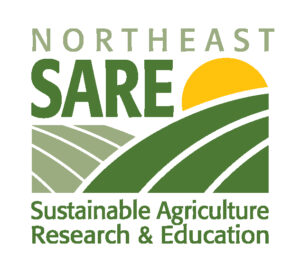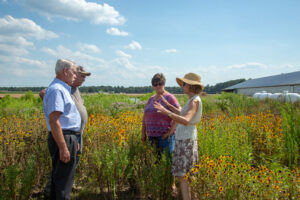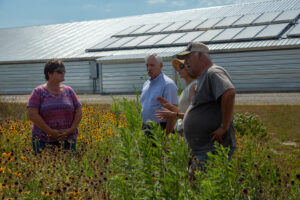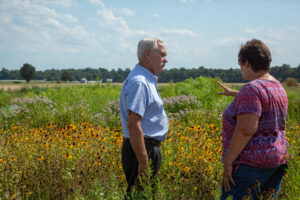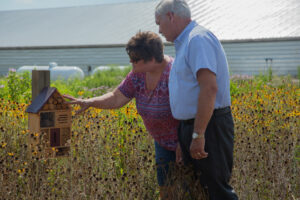Final report for FNE17-873
Project Information
The purpose of our project was to install a mixed vegetative buffer adjacent our poultry houses that was cost-effective, provided habitat for pollinators and was perceived by farmers and the public to be good environmental stewardship. We installed a dual function buffer consisting of clover, native annuals and perennials, trees and shrubs at and around our existing poultry houses. Plants were selected that attract native bees and pollinators. We conducted bee counts on pollinator areas as well as tracked time and cost associated with both pollinator areas and control areas and we saw an increase in bees, pollinators and even birds in those ares. A sign was erected to draw attention to the effort by the public, as well as press releases by the agricultural industry.
The cost effectiveness of this pollinator patch may be a hard sell if the poultry farmer has to bear the entire cost. If plugs are purchased and a landscaper is paid to install, it can cost well over $1000 per acre at the most expensive. Seeding wildflower seeds is less expensive. Both types of plots require watering and weeding which is more labor intensive than mowing a lawn. Even though we believe the benefits outweigh the cost over the long haul, it may not be implemented by the poultry farmer if it is not a priority due to more pressing needs. In a typical farmer funded pollinator plot, native wildflower seed would be the most cost effective method to plant the pollinator plot. The look is very different than a well-manicured lawn so it would take an adjustment of attitude to adopt plots like this. However, these types of plots, we found, please the public and improve their perception of poultry farming, we believe. We hope this study, the first of its kind, will encourage other poultry farmers to try it out.
In conclusion, we received very positive feedback from local farmers, the general public and related agricultural support industries such as the poultry interrogators, Delmarva Poultry Industry and the Delaware Department of Agriculture. With the support and financial backing of these industries we feel like this effort will gain momentum and continue to add a splash of beauty and purpose to area poultry facilities.
We set out to test a new practice, installing a dual function, mixed vegetative buffer adjacent to one of our poultry houses. This new buffer design would provide the odor and dust reduction function of established vegetative environmental buffers, and add habitat and pollen and nectar resources for honey and native bees.
We wanted to determine whether installing this buffer will be cost-effective, provide habitat for bees, and be perceived by farmers and the public as good environmental stewardship.
Objective 1: Measure the economic viability of installing a dual function, mixed vegetative buffer around our poultry house by accounting for the cost of installation and maintenance, and comparing that to the cost of maintaining our existing grassy buffer system.
Objective 2: Determine if this buffer provides forage resources for honey and native bees and other pollinators by conducting bi-weekly counts of flower visitation in the Pollinator Plot. These will be compared to similar counts in the Control Plot.
Objective 3: Document the reaction of poultry farmers and the public to the pollinator buffer, and determine how this impacts their view of poultry houses and their perception of environmental
stewardship.
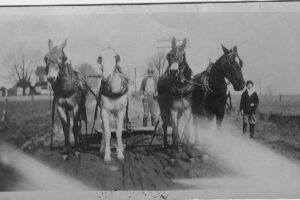
More about our farm: 10-26-10-DELMARVA-FARMER1
We chose to propose the poultry pollinator project due to several different reasons. Delmarva is known for its poultry industry and within the last few years new poultry houses are popping up all over the countryside. This is great for the farmer's cash flow, but many neighbors that have moved into agricultural areas are not liking the additional expansion. Poultry farms produce poultry for human consumption, and they also produce manure, odor and dust. Around every poultry house are a few acres of grass that has to be mowed at least once a week in the summertime. Most poultry houses are near crop land acres that produce either grains or vegetables. Vegetable production requires bee hives to pollinate the crops. If we could put to use the land around poultry houses to help provide additional forage and nectar sources for native and honey bees that would be a win win for all. Farmers would have less grass to mow, fewer bee hives to rent, plots would be attractive to look at and hopefully the public would realize that poultry houses are not detrimental to the health and well being of all that live near them.
This is especially important to our farm because we are a century farm that has been in the same family for over 5 generations. We live on a main highway that takes traffic right by our farm. When our forefathers began this farming operation Rt 14 was dirt and my husbands grandfather and great grandfather would grade the dirt road with a team of mules. Now that the population is growing in our area our farm is under pressure for development. It is important to us to continue farming on the same land. The addition of 2 more poultry houses has added to our cash flow but wasn't popular with all the neighbors. We do want people to understand that we wish to be good stewards of the land, water and air. We are doing all we can do to help people "see" this. A nice pollinator plot, blooming with native plants and flowers that helps the native bees have additional forage and nectar sources just made sense. If it helps cut down on the dust and odor from the poultry houses than it's just one more way we are being a good neighbor.
Cooperators
- - Technical Advisor (Educator)
- (Educator and Researcher)
Research
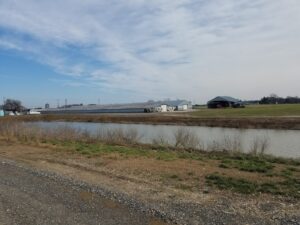
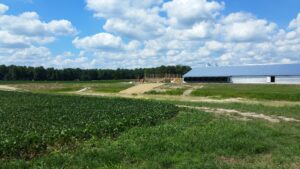
We chose to compare the cost and pollinator benefit of two land management regimes, a Pollinator Plot and a Control Plot. The Pollinator Plot is adjacent to our two new poultry houses. The Pollinator plot area is 400 ft x 150ft, and located around a new stormwater pond. In early March of 2017 we applied glyphosate to the entire east (side two) and north end (area three) of this pollinator patch area. This area was divided and planted into 3 separate areas.
Area one is located on the west side of the storm water pond and is approximately 400ft by 40ft. We have partnered with the NRCS and Delmara Poultry Industry and a variety of bee friendly trees and shrubs were planted in this area in October of 2017. Miscanthus grass was also planted at the tunnel fan exhaust
Area two is located to the east of the stormwater pond and approximately 400ft by 40ft. Area two was treated with glyphosate to knock down weeds, tilled and approximately 1 week before clover was seeded a second application of glyphosate was applied. Area two was again tilled prior to sowing of a 5-clover seed mix in Mid April. A 5-clover mix was sowed at a rate of 10lb per acre. We estimate this area at 3/4 of an acre. Cost was $26.25 including freight for this 5-clover seed mix. Cost of seeding clover by Sussex Landscaping was $350.00.
Area three is approximately a 1/2 acre located at the North end of the storm water pond and adjacent to the patch of clover that was planted. It too received a first application of glyphosate in early March of 2017, let sit, tilled and 1 week prior to the planting of native perennial plugs received the second application of glyphosate and was tilled same day as perennial plugs were planted.
Species were selected to give spring to fall blooms. The early bloom perennial is Baptisia australis, False Blue Indigo. Mid season bloom perennials are Eupatorium, Boneset, Asclepias tuberosa, Betterfly weed, Verbena hastata, Blue Vervain and Chamaecrista fasciculata, Partridge Pea and Monarda fistulosa, Wild Bergamont. Late season blooms included Solidago speciose, Showy Goldenrod and Symphyotrichum novae-angliae, New England Aster. Jim Passwaters from Sussex Landscaping purchased perennial seed native to this area, cold treated and planted seed at his growing facility in February 2017.
In April of 2017, area three was planted with the plugs that Mr. Passwaters had started in his greenhouse months before. Approximately 5000 plugs were planted in area 3 at a cost of .50 cents a plug. Cost of Sussex Landscaping to plant 5000 plugs was another .50 cents a plug. Perennial pollinator patch was also overseeded with perennial seeds at a rate of 8lbs per 1/2 acre at a cost of $50.00 a pound. Totaling $400.00 for seed and an additional $350.00 for Sussex Landscaping to seed this 1/2 acre area.
A plot of clover was also planted along the eastern edge of the storm water pond in late March/ early April. We planted a grouping of sunflowers on one side of the plot to help provide an additional source of nectar and habitat for our potential pollinator visitors. For the next 8-12 weeks we irrigated the plot to help insure the plugs, seeds and shrubs had the best possible start. Dr. Faith Kuehn meant with the MCA Ag Science teacher, Judith Bruns and conducted a class on how to conduct bee counts to interested MCA students.
Our plot will need to be mowed in Mid March of 2018. We plan on replanting more sunflowers and possibly spot replanting the clover to fill in where some excessive rain caused the banks of our storm water pond to wash out.
Our control plot is just grass, so we spent approx. 25 minutes weekly mowing that area as needed.
In the spring of 2018, we mowed the established pollinator plot in late March. As the spring progressed we noticed many varieties of native pollinators that began to grow, bud and bloom. The established plugs really took off and gave us a flush of late spring blooms, even thru the very wet spring that we experienced. Having the perennials planted as plugs the spring before gave us a much needed head start and showing of spring blooms. As the summer progressed the perennials continued to bloom at their appropriate time, providing much needed nectar and forage for honey and native bees. This area was hit hard with extremely dry weather for a period of approximately 4 weeks during midsummer of 2018, but the native varieties that were planted held up with no additional irrigation needed. The pollinator plot was maintenance free during the spring, summer and fall of 2018 with the exception of the one mowing in the spring.
Bee counts were conducted by the MCA FFA students on May 15, 2018. The students counted 4 honey bees and 2 tiny bees in the area where the clover was planted. No bees were counted on the control patch.
The control plot continued to be mowed on a weekly basis, sometimes twice a week during the rainy periods and every 7-10 days in the dry period.
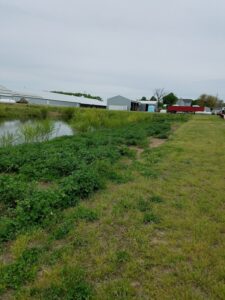
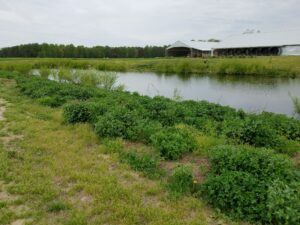
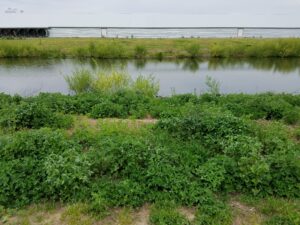
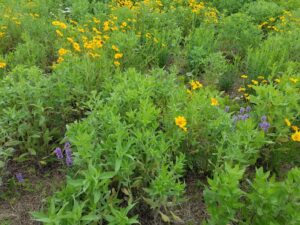
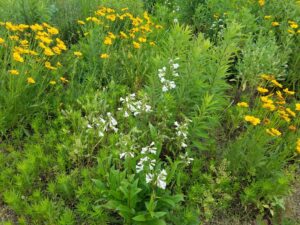
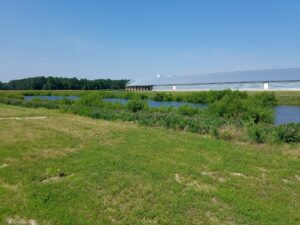
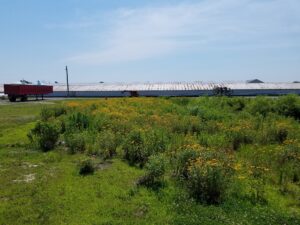
Time to irrigate the planted pollinator plot was approx 3 hours a day. Sprinklers had to be moved to reach the entire area. Conditions in mid to late summer were dry, so irrigation was a must to establish the plot the first year it was planted. This was more of a job than I anticipated. The plugs at first really struggled, especially in the hot, summer breezes, but once established the first year they didn't require any additional irrigation the second year.
Weeds also had to pulled or sprayed to eliminate them from taking the plot over. We used a hand wick in some areas and pulled some of the weeds that were near the sunflowers that had been planted. Control was good. We expect minimal weed pressure the second year.
We prepared the bank of the storm water pond by spraying with round up a few weeks before planting and worked it with a disk. Then the clover patch was planted on the eastern edge of the storm water pond. The next day we received terrental rain which caused some wash outs of the clover seed and the bank of the pond. Hind sight we should have just planted the seed thru the dead grass that we had sprayed.
The control plot was mowed on a weekly basis, unlike the plot of pollinators. Many people have commented on the pollinator plot looking very attractive and adding beauty to an otherwise plain, useless area. Time was certainly saved by us not having to mow the pollinator plot. We certainly see the benefit of investing in an area with native wildflower seed, because the time saved in mowing will long outlast the initial cost of the seed itself.
Bee counts were completed by the students of the Milford Central Academy FFA students on 2 occasions. A total number of 4 students visited the farm to conduct the bee counts under the direction of the MCA FFA teacher and adviser Judith Bruns. Bee counts were taken on September 13, 2017 by the group of students. Counts were taken at approximately 3:45 PM in the front bed (control) 6 flies and 6 butterflies were spotted. The rear pollinator plot a total of 5 honey bees and a bumble bee were counted.
Again on May 15, 2018 the group of students returned to take a bee count. The clover batch was showing some bloom. The students counted 4 honey bees and 2 tiny bees. No documentation was made as to the time of day that this count was completed, nor the counts that they discovered on the control plot.
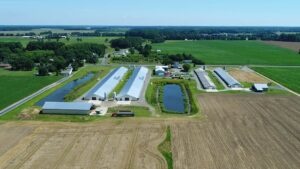
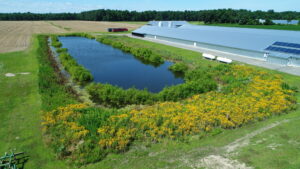
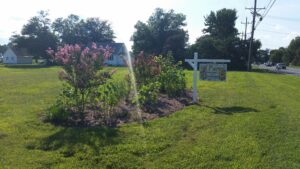
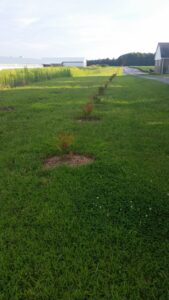
The results of the pollinator plot have been mostly positive. Many visitors to the farm have commented on the pretty wildflowers and habitat that have been created by the planting of the wildflowers. Bees, butterflies, and many different types of insects are visiting the pollinator patch during the daytime hours, which give the area a very natural organic feel. The pollinator patch has become the main attraction, not the poultry houses.
With funds from the Delmarva Poultry Industry (DPI) perennial miscanthus grasses have been planted at the tunnel fan ends of the poultry houses, assisting with the capture of feathers, dust and even reducing the noise that is associated with the operation of the poultry house tunnel fans during their use. The Natural Resource and Conservation Service has partnered with poultry growers to provide a cost share to plant vegetative buffers around poultry houses to act as a visual barrier which also helps reduce air and noise pollution, while concealing the actual poultry house from area neighbors and passerby's.
The objective of making a poultry house pollinator patch a place for foraging native and honey bees to visit was a success. Bee counts increased in the pollinator area, unlike the control area. I also noticed an increase in birds and insects as well.
The objective of making a poultry house "complex" more attractive, environmental friendly and compatible to the neighborhood have certainly been meant as well. I believe the neighbor's see the effort that we are making to attempt to make our poultry farm as pleasant as possible, and with the combination of funds from NE SARE, USDA, NRCS and DPI have made it a complete package.
Once we got thru the first year, the second year was very encouraging. Due to the curb side appeal of this project, and the location of our farm we plan to implement more wildflower pollinator patches that will make our grounds around the poultry houses more attractive. One example, we have difficulty mowing is in between the 2 new poultry houses due to swales that we installed in between the poultry houses to improve drainage. By planting wildflower seeds and creating a pollinator patch, this area will be very attractive, provide beneficial forage for pollinators and not have to be mowed. That to me is a win win situation!
A few drawbacks are that the first year the plot is far from "beautiful". If you are the type that likes a well manicured lawn than establishing a wildflower pollinator patch may not have the appearance that you desire. A wildflower pollinator patch has a very natural, meadow-like appearance. The public perception of wildflowers to attract honey and native bees is a positive. Our plot began to really take shape as the first summer came to an end.
On areas that you have seeded, you have to contend with the rain washing out seed and plugs, weeds springing up where the plants haven't filled in the spaces yet, and Japanese beetles and other insects feasting on certain species of plants. When the rain stops, you have to make sure you have adequate water supply, hose and sprinklers to water such a large area while it is getting established. Having a water source close by to irrigate the plot in the beginning stages is a must, whether it be a hose connected to a poultry house or a water wagon. Wildflower seed and or plugs are quite an investment, and you wouldn't want to lose any plants that have begun to grow and flourish. Thanks to the National Institute of Food and Agriculture, U.S. Department of Agriculture, through the Northeast Sustainable Agriculture Research and Education program under the project number FNE17-873, we were able to try both planting of native perennial plugs and native perennial wildflower seed.
The cost effectiveness of this pollinator patch may be a hard sell if the poultry farmer has to bear the entire cost on his or her budget. I believe the benefits out way the cost over the long haul, but if this isn't a priority for the poultry farmer it may not be implemented due to more pressing needs. In a typical farmer funded pollinator plot, native wildflower seed would be the most cost effective method to plant the pollinator plot.
Education & Outreach Activities and Participation Summary
Drone footage has been downloaded below of that day. As you can see the pollinator plants were looking great!
The Delaware Department of Agriculture featured our farm as well as other pollinator plots in the state at the Delaware State Fair in July of 2018. They estimate over 10,000 people passed through the Ag Commodity Building during the 10 day event.
On July 25, 2018 Kayla Fusselman, the 2018 National Honey Bee Queen visited our farm. Kayla was crowned at the American Beekeeping Federation Conference in January 2018. She toured many different farms that day and also visited the Delaware State Fair Ag Commodity Building. Accompanying her from farm to farm was State Apiarist, Richard Goerger.
Participation Summary:

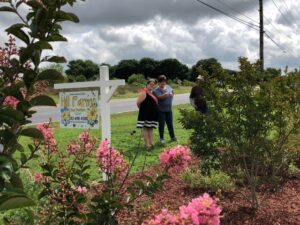
Marvin & Tina Hill with Kayla Fusselman at Hill Farms in Milford Delaware.
Kayla was crowned the 2018 National Honey Queen at the American Beekeeping Federation Conference in January 2018.
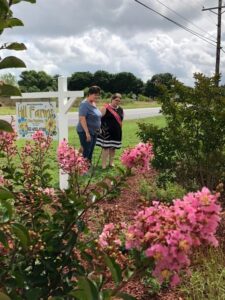
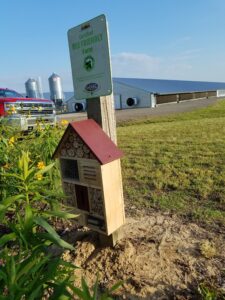
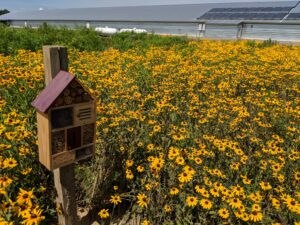
Bee houses were placed on roadside plot and pollinator plot in between poultry houses to encourage resident honey bees, not just visitors!
Once the pollintator plot was planted with seeds, plugs and shrubs in April 2017 Dr. Faith Kuehn scheduled a time to meet with the local middle school ag science teacher and FFA Advisor and interested students. At this time, Dr. Kuehn explained how to conduct bee counts on the planted pollinator plot. On September 13, 2017 the students visited the farm and conducted the pollinator count. This spring and summer of 2018 additional bee counts will be conducted by the Milford Central Academy FFA students.
Several agricultural publications ran stories on our pollinator plot. The news articles helped spark interest from other poultry growers and the poultry interrogators. For instance, our poultry service man came to the farm and asked us where the pollinator plot was located that he had read about in the newspaper. DPI-Pollinator-Story-6.2017
Delaware Secretary Michael T. Scuse, Stacey Hofmann and Jimmy Kroon visited our farm to see and learn about our pollinator project. Mr. Kroon took drone footage of the grounds and pollinator project. Delaware Department of Agriculture featured our pollinator plot at the Delaware State Fair in July of 2018. They estimate over 10,000 people visited the Ag Commodity Building during this 10 day period.
The National Honey Bee Queen also paid our farm a visit during her visit to the Delaware State Fair in July of 2018.
Lancaster Farming newspaper published a story featuring this pollinator plot.
http://www.lancasterfarming.com/news/southern_edition/delaware-poultry-farmers-give-bees-a-boost/article_72a1b9d3-a6e4-5969-ab1b-e6f2ef70a607.html
We are grateful for the funding of this project by USDA/NIFA Sustainable Agriculture Research and Education, project number FNE17-873.
We believe the investment in this project has brought awareness to the poultry industry, agriculture departments, farmers and neighbors of the importance of adding pollinators to unused spaces to benefit the pollinators and the surrounding farms and neighborhoods.
Learning Outcomes
I do not believe this concept has even been thought of by just the poultry farmer. If the farmer also plants row crops or vegetables than they understand the need of the pollinators (and the cost). Average price is $75 a hive and they recommend one hive per acre. The pollinator plot has been placed in such an area that it is adjacent to fields that grow vegetables that require pollinators to pollinate the crop. Any additional pollinators that we can provide habitat for is a plus!
Poultry houses are often not the most popular structures in the neighborhood. The pollinator plot adds the simple beauty of native flowers, plants and shrubs and helps capture some of the dust/odor that is comes along with raising poultry.
Project Outcomes
NESARE Farmer grant FNE17-873 Poultry Pollinator Buffers
This material is based upon work supported by the National Institute of Food and Agriculture, U.S. Department of Agriculture, through the Northeast Sustainable Agriculture Research and Education program under subaward number FNE17-873.
